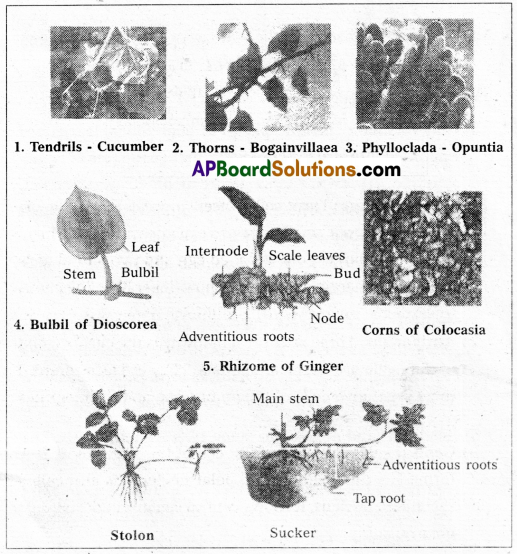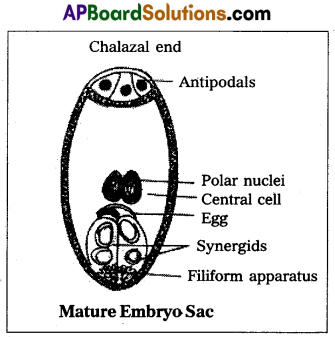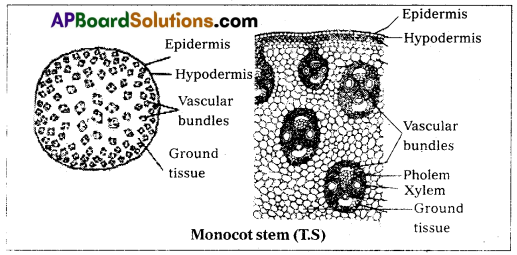Successful navigation through AP Inter 1st Year Botany Model Papers and AP Inter 1st Year Botany Question Paper May 2018 builds students’ confidence in their exam-taking abilities.
AP Inter 1st Year Botany Question Paper May 2018
Time: 3 Hours
Maximum Marks: 60
General Instructions:
Note : Read the following instructions carefully.
- Answer all questions of Section – ‘A’. Answer any six questions out of eight in Section – ‘B’ and answer any two questions out of three in Section – ‘C’.
- In Section – A, questions from Sr. No’s. 1 to 10 are of “Very Short answer Type”. Each question carries two marks. Every answer may be limited to 5 lines. Answer all the questions at one place in the same order.
- In Section – ‘B’, questions from Sr. No’s. 11 to 18 are of “Short Answer Type”. Each question carries four marks. Every answer may be limited to 20 lines. ‘
- In Section – ‘C’, questions from Sr. No’s. 19 to 21 are of “Long Answer Type”. Each question carries eight marks. Every answer may be limited to 60 lines.
- Draw labelled diagrams wherever necessary for questions in Section – ‘B’ and C’.
Section – A (10 × 2 = 20)
Note : Answer all questions. Each answer may be limited to 5 lines.
Question 1.
Give the scientific name of Mango, identify the generic name and specific epithet.
Answer:
Mangifera indica. Its generic name is Mangifera and specific epithet is ‘indica’.
Question 2.
Name two diseases caused by Mycoplasmas.
Answer:
a) Witches broom disease in Plants.
b) Pleuropneumonia in Cattle.
c) Mycoplasmal Urethritis in Human beings.
Question 3.
Who discovered the cell and what was the book written by him?
Answer:
‘Robert Hooke’ discovered the cell. ‘Micrographia’ was the book written by him.
Question 4.
What is meant by pulvinous leaf base ? In members of which angiospermic family do you find them ?
Answer:
The swollen leaf base is called pulvinous leaf base. It is seen in leguminasae, family.
![]()
Question 5.
What are aggregate fruits ? Give two examples.
Answer:
The fruits which develop from multicarpellary, apocarpous ovary called aggregate fruits. Each carpel develops into fruitlet and all these fruitlets aggregate together into a single fruit. Ex : Anona, Naravalia.
Question 6.
Write the floral formula of solanum plant.
Answer:
Br or Ebr, Ebrl, O, K(5) C(5)A5 G(2).
Question 7.
Which of the following is not correct ?
a. Robert Brown discovered the cell.
b. Schleiden and Schwann formulated the cell theory.
c. Virchow explained that cells are formed from pre-existing cells.
d. A unicellular organism carries out its life activities within a single cell.
Answer:
a. is not correct.
the cell was discovered by Robert Hooke.
b. is correct
c. is correct
d. is correct
Question 8.
Explain the Zwitterionic form of an aminoacid.
Answer:
At a specific PH the amino acid carries both the +ve and .-ve charges in equal number and exists as dipolar ion. It is also called as zwitterionic form. At his point, the net charge on it is zero.
Question 9.
If a tissue has at a given time 1024 cells, how many cycles of mitosis had the original parental single cell undergone ?
Answer:
- Orthotropous : The micropyle, chalaza and funiculus are on the same vertical plane. Ex. : Polygonum.
- Anatropous : The body of the ovule bends at an angle of 180 as a result, the micropyle lies close to funicules. Ex. : Sunflower.
- Campylotropous : The body of the ovule bends at right angles to the funicle. The embiyosac is slightly curved. Ex.: Bean.
Question 10.
Climax stage is achieved quickly in secondary succession as compared to primary succession. Why ?
Ans. Secondary succession, starts when first colonised plants destroyed. Such area already contains already soil, so climax stage achieved quickly than primaiy succession.
![]()
Section – B (6 × 4 = 24)
Note : Answer any six questions. Each answer may be limited to 20 lines.
Quetsion 11.
Give a brief account of Dinoflagellates.
Answer:
- Dinoflagellates are mostly marine and photosynthetic. They appear yellow green, brown, blue or red depending on the pigments in their cells.
- The cell wall has stiff cellulose plates on the outer surface.
- They have two flagella and produce spinning movements. So these protists are called “whirling whips”.
- The nucleus has condensed chromosomes which are without histones. This is called mesokaryon.
- Some dinoflagellates like Noctiluca show bioluminescene.
- Red dinoflagellates like Gonyaulax undergo rapid multiplication and make the sea appear red (Red tides in Medeterranian sea).
- Toxins produced by them may kill fishes.
Question 12.
Differentiate between red algae and brown algae.
Answer:
| Red algae | Brown algae |
| 1. They belong to class Rhodophyceae. | 1. They belong to class Phaeophyceae. |
| 2. Most of them are marine and some are fresh water forms. | 2. They live in fresh water, brackish and salt water. |
| 3. Cell wall is made up of cellulose, pectin and polysulphate esters. | 3. Cell wall is made up of Cellulose and algin. |
| 4. The thallus is multicellular. | 4. The thallus range from simple branched filamentous forms to profusely branched forms. |
| 5. Flagella are absent. | 5. Flagella are 2, unequal and lateral. |
| 6. The major pigments are Chlorophyll-a,d, and r-phycoerythrin. | 6. The major pigments are Chlorophyll-a, c, carotenoids and fucoxanthin. |
| 7. Food materials are stored the form of Floridian starch, | 7. Food materials are stored in the form of mannitol and laminarin. |
| 8. Asexual reproduction occurs by non motile spores. | 8. Asexual reproduction occurs by biflagellate zoospores. |
| 9. Sexual reproduction is by non-motile gametes. | 9. Sexual reproduction is by motile gametes. |
| 10. E.g.: Polysiphonia, Porphyra | 10. E.g. : Ectocarpus, laminaria. |
Question 13.
List the changes observed in angiosperm flower subsequent to pollination and fertilization.
Answer:
- Calyx, Corolla, Stamens, style and stigma wither away.
- Ovary develops into fruit.
- Ovules develop into seeds.
- The zygote develops into embryo.
- Primary endosperm nucleus develops into endosperm.
- The synergid and antipodals disintegrates.
- Funicle of the ovule develops into stalk of the seed.
- Integuments develop into seed coats.
- Micropyle changes into seed pore.
- Hilum changes into scar of the seed.
Question 14.
Desecribe the non-essential floral parts of plants belonging to Fabaceae.
Answer:
In Fabaceae, the nonessential floral parts are Calyx and Corolla.
Calyx : Sepals 5, gamosepalous, valvate aestivation and odd seapal is anterior.
Corolla: Petals 5, polypetalous, papilionaceous type consisting of large posterior petal called standard petal, two lateral petals called wings and the two anterior fused petals are called keel petals which enclose essential organs. They show descendingly imbricate aestivation.
Question 15.
Differentiate between Rough Endoplasmic reticulum (RER) and Smooth Endoplasmic reticulum (SER).
Answer:
| RoughEndoplasmic Reticulum | Smooth Endoplasmic Reticulum |
| 1. ER studded with ribosomes is called Rough ER. | 1. ER without ribosomes is called Smooth ER. |
| 2. These are mainly composed of cisternae. | 2. These are mainly composed of tubules. |
| 3. They are associated with nuclear membrane. | 3. They are associated with plasma membrane. |
| 4. They mainly involved in Proteinsynthesis. | 4. They mainly involved in in Lipid synthesis. |
![]()
Question 16.
Which division is necessary to maintain constant number of chromosome number in all body cells of multicellular organisms and why?
Answer:
Mitosis. It results in the production of two daughter cells which resembles the parent cell. They show similar genetical complement. The growth of the multicellular organisms is also due to mitosis. Cell growth results in disturbing the ratio between the nucleus and cytoplasm. So mitosis is essential to restore the nucleo – cytoplasmic ratio. A very significant contribution of mitosis is cell repair. Mikotic divisions in meristematic cells, the apical and lateral meristems results in continuous growth of plants throughout their life.
Question 17.
State the location and function of different types of meristems.
Answer:
Based on the position, meristems are classified into three types.
They are
- Apical meristems : The meristems that are present at the tip of the stem and at the tip of the root are called apical meristems. They help in linear growth of the plant body.
- Intercalaiy meristems : The meristems that are present in between mature tissues are known as intercalary meristems. They contribute to the formation of the primary plant body and also involves in internodal length.
- Lateral meristems : The meristems that occur in the mature regions of roots and shoots peripherally called lateral meristems. They help in increase in thickness of the plant organs.
E.g. : vascular cambium and cork cambium.

Question 18.
Give detail the anatomical adaptations shown by xerophytes.
Answer:
- Epidermis is covered with thick cuticle to reduce the rate of transpiration.
- Epidermal cells may have silica crystals.
- Epidermis may be multilayered.
- Stomata are generally confined to lower epidermis of leaves and present in pits (Sunken) in some plants.
- Mechanical tissues are well developed.
- Vascular tissues are relatively well developed.
Section – C (2 × 8 = 16)
Note : Answer any two questions. Each answer may be limited to 60 lines.
Question 19.
Explain how stem is modified variously to perform different functions.
Answer:
Stems are modified in several ways to perform different functions.
They are :
1) Tendrils : Slender, spirally coiled structures which may develop either from auxiliary bud (cucumber) or from terminal bud (grapes) are called tendrils. They help in climbing.
2) Thorns : Buds are modified into woody, strainght pointed thorns which protect plants from grazing animals.
Ex : Citrus, Bougain villaea.
3) Phylloclade : In some plants of acid zones, leaves are modified into scales or spines to reduce the rate of trans-piration. In such plants, stems are modified into flattened, green structure which carryout photosynthesis. Such stems are called phylloclades.
Ex : In euphorbia stem is cylindrical, in casuarina needle like, and in opuntia – flattened, fleshy green.
4) Bulbils : In some plants, the vegetative buds or floral buds store food materials. At maturity, may detach from the parent plants, develop adventitious roots, grow as new plants thus help in vegetative reproduction. Ex : Diascoria.
5) Underground stems : In some plants, stem grows into soil, store food materials, show perennation, to resist unfavourable conditions and also help in vegetative reproduction. Such stems are called underground stems.
Ex : Rhizome – Ginger, corn – colacacia.
6) Sub aerial stems : In some plants, some part of the stem is underground and some part is aerial. Such stems are called sub aerial stems. In such plants, slender, lateral branches arises from the base of the main axis, grow vertically, arches downwards, produce adventitious roots when touches the ground. When they separates from the parent plant, they develop into new plants they help in vegetative reproduction.
Ex : Stolons – Nerium, Jasmine

Question 20.
With a neat labeled diagram, describe the parts of a mature angispermic embryo sac. Mention the role of synergids.
Answer:
Mature angiosperm embryosac shows three parts.
They are :
1) Egg apparatus
2) Antipodals
3) Central cell

- Egg Apparatus : Three cells present towards the micropyle of the embryosac together called egg apparatus. Of which, the central, largest one is called egg and two lateral cells are called synergids. Synergids show finger like projections towards the micropyle called filliform apparatus.
- Antipodals : Three cells present towards the chalazal end of the ovule are called antipodals. They are also referred to as vegetative cells of the embryosac and disintegrates before or after fertilisation.
- Central cell : It is the largest cell of the embryosac. It is formed by the fusion of two polar nuclei. It is also called secondary nucleus. It shows central vacuole and 2 haploid polamuclei.
Role of synergies :
- The filliform apparatus of the synergids absorbs food materials from the Nu cells and supplies to embiyosac.
- It also secretes some chemicals which direct the growth of the pollen tube towards embryosac.
![]()
Question 21.
Describe the T.S. of a monocot stem.
Answer:
The structure of monocot stem can be understood well by observing the T.S. of stem of Zea mays. It shows 4 distinct parts, namely
1. Epidermis,
2. Hypodermis,
3. Ground tissue and
4. Vascular bundles.
1) Epidermis : It the outermost layer composed of rect-angular or tubular living cells arranged closely and compactly without intercellular spaces. The cells contain vacuolated protoplasts with a single nucleus but chloroplasts are absent. A waxy layer called ‘cuticle’ is deposited on the external surface of the epidermis. Cuticle prevents the evaporation of water from the plant body. Trichomes are absent. Numerous stomata are found in the epidermis through which exchange of gases occurs.
Epidermis gives protection to the inner tissues, helps in the exchange of gases and also prevents the evaporation of water.
2) Hypodermis : A distinct cortex is absent in Monocot stems. However a thick walled hypodermis is found beneath the epidermis. The cells of hypodermis are sclerenchymatous and are arranged compactly in 3 – 4 rows, without any intercellular spaces. It gives mechanical strength to the, stem.
3) Ground tissue : A major part of the stem is formed by an extensive soft, parencymatous tissue called the ground tissue. The peripheral layer consists of smaller cells while the inner layers show bigger cells. The cells of peripheral layers are chlorenchymatous and are concerned with assimilation of food materials. The inner layers of cells are concerned with storage of food materials. In monocot stem endodermis is absent.
4) Vascular bundles: Numerous vascular bundles are found scattered irregularly in the ground tissue. This kind of arrangement is called ‘atactostele’. It is considered an on advanced character. The inner vascular bundles are bigger in size and far apart from one another. The outer vascular bundles are smaller and are close to one another and found in one or two circles.
Each vascular bundle is oval in shape and shows xylem and phloem together on the same radius. There is no cambium between xylem and phloem. Hence the vascular bundles are called conjoint, collateral and closed. Xylem is at the lower side and phloem at the upper side of the vascular bundle. Each vascular bundle is enclosed by a sheath of sclenren- chymatous fibres. Hence it is called fibre vascular bundle.
Xylem consists of tracheids, vessels, fibres and parenchyma. Xylem vessels are few in number (4) and are arranged in “Y” shape. One or two protoxylem cells are crushed forming lysigeneous cavity called protoxylem lacunae which store water pholem consists of sieve tubes and companion cells. Pholem parenchyma is absent Medulla, Medullary rays and pericycle are also absent,
